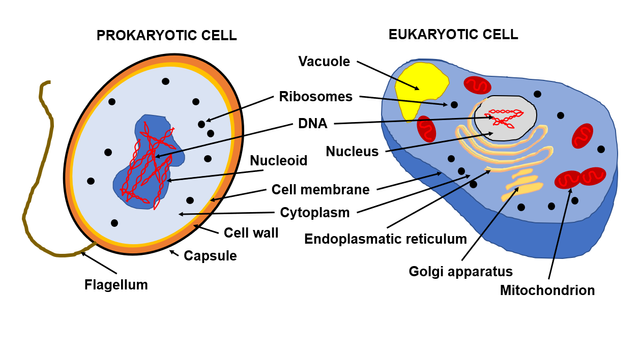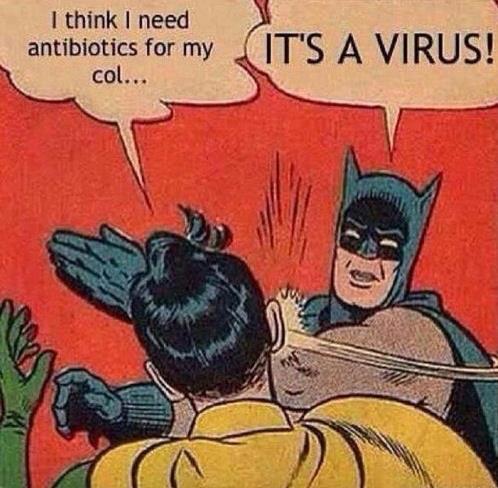
Dear Steemians, today I would like to introduce you to basics of microbiology and explain to you differences between viruses, bacteria and yeast (spoiler: yes, they are not the same). I will try to do so in an interactive and hopefully fun manner. You will be given 5 questions and your goal is to try to come up with right answers...and then see how wrong you were! :D
Let’s begin with something easy.
Question 1 – Are they all alive?
Allright, sorry that I began with this tricky one, but I could not help myself. Well, the answer is a question really: How do you define life? There is luckily an answer to this one- there are 7 basic traits defining life (in biological context):
1. Homeostasis - the ability to regulate internal environment and maintain stable conditions
2. Organization - being composed of one or more cells
3. Metabolism - being able to form (anabolism) or decompose (catabolism) cellular components
4. Growth - anabolism has to be larger than catabolism
5. Adaptation - ability to change as response to environment
6. Response to stimuli - to be able to somehow react to external cues such as light, chemicals, etc.
7. Reproduction - the ability to produce offspring (either sexually or asexually)
So, are they all alive or not?! To make you understand lets dig deeper. The image bellow shows virus, bacteria and yeast. Looks quite similar, right? All alive then, right? Wrong!

Question 2 – If they are not all alive, then who is the culprit?
The answer: Viruses. Why? For several reasons. Let’s start with a shocker – viruses are non-cellular. They are basically DNA/RNA coated in proteins and lipids. This means that they are unable to metabolize anything and can’t even reproduce on their own. How are they even here? Well, that is because they are intracellular parasites meaning that they are able to penetrate cells and they reproduce and metabolize inside. On the other hand, viruses do show some traits of life. They have their own genes and evolve by the rules of natural selection (survival of the fittest). They can self-assembly inside of host cells and even though this is tad different than cell-division, but basically quite similar. That is also the reason why this is quite controversial question among scientists and probably the best definition (at least for me) is that viruses are organism at the edge of life. Quite poetic, don’t you say?
Question 3 – Are both bacteria and yeast cellular organisms?
Yes, they are. But are they the same? Hell no! Even though, they both represent cellular microorganism there is one crucial difference. Bacteria are prokaryotic, whereas yeast are eukaryotic microorganisms.
Question 4 – What is the difference between prokaryotes and eukaryotes?
The main difference between prokaryotes and eukaryotes is, that prokaryotes lack any membrane organelles. What the hell are membrane organelles you ask? Well, imagine your body and go a bit inside. Yes, you have organs inside your body. Brain gives orders to other parts of your body, lungs breath, stomach digests. In the same manner eukaryotic cell possess its own organs termed organelles.
Let me give you a quick list and basic functions of organelles:
Nucleus – let’s say a brain of cell, stores DNA and controls all processes
Mitochondrion – energy and respiratory centre, equal to lungs
Endoplasmatic reticulum – protein folding and transport
Golgi apparatus – a post office really, it sorts, labels and sends proteins to different cell destinations
Vacuole – stores stuff, may be present in some bacteria as well
Chloroplast – turns sunlight into energy
Lysosome – a cellular stomach that can degrade stuff
(note: not all of these organelles are present in all eukaryotic cells!)
Then there are some similarities as well. Both prokaryotes and eukaryotes do contain ribosomes, which are small molecular factories capable of creating proteins of all sorts. Another thing they have in common is cytoskeleton, which gives the cells some level of protection as well as movement capabilities. And let’s not forget cell membrane and cell wall (which is not always present in eukaryotes) that form the surface of cells and define their shape as well as cytoplasm that forms the inside of cells. Bacteria have their own DNA as well, but theirs does not reside inside the membrane bound nucleus, but rather in the form of nucleoid. Some bacteria have also protective coat termed capsule and are equipped with flagellum to increase their movement capabilities. You can see visual difference of prokaryotes and eukaryotes on the picture bellow (NOT ALL ORGANELES INCLUDED).

Question 5 – Story time: Little Peter has severe flu. Peter takes antibiotics. Peter dies. Why?
Because antibiotics are not effective against viral infections! REMEMBER THAT. Flu is a disease caused by influenza virus. Antibiotics basically work in a way that they hinder some cellular functions, such as cell division or metabolic pathways. Viruses are not cells, yeah, they require host cells, but antibiotics will not kill them. Antibiotics might be used to prevent secondary bacterial infections due to primary viral infections. So next time when you have sore throat and find some leftover antibiotics at home, please think twice. Because they may not help you at all.

Summary
Let’s take a step back and summarize all the thing we learned todays (in a form of this table).

Hopefully you did learn something new today. I do want to continue in this so-called microbiology series if you find it interesting. If you have any questions or comments, please let me know!
Have a great day and don’t abuse antibiotic usage!
References:
https://en.wikipedia.org/wiki/Outline_of_life_forms
https://en.wikipedia.org/wiki/Life
https://en.wikipedia.org/wiki/Virus
https://en.wikipedia.org/wiki/Prokaryote
https://en.wikipedia.org/wiki/Eukaryote
https://en.wikipedia.org/wiki/Organelle
https://www.drugs.com/article/antibiotics-and-viruses.html
Yous said about viruses:
"They are basically DNA/RNA coated in proteins and lipids. "
I dont know but I think prokaryotes or eukaryotes would align with this definition also, dont you think?
I love you though.
Downvoting a post can decrease pending rewards and make it less visible. Common reasons:
Submit
Yes, that might be true. The same definition applies to you and all aliens as well. :D
What I meant is, that viruses are DNA/RNA in special coat of proteins termed capsid and sometimes they have another special coat of lipids (when not inside the cell).
Love you too.
Downvoting a post can decrease pending rewards and make it less visible. Common reasons:
Submit
Doesn't this mean that yeast is superior in a way?
Downvoting a post can decrease pending rewards and make it less visible. Common reasons:
Submit